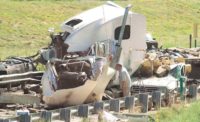In the Hot Zone: A Talk About the Great Heat Wave of 2023

Editor-in-Chief Blair says high heat is a Phoenix way of life as his family dog, Rogue, naps comfortably in the sun.
Photo by Scott Blair
July 2023 will go in the record books for its remarkable persistent heat. Phoenix saw the mercury pass 100° F for 22 days in June, and so far in July, there have been 25 days where the high temperature never fell below 110°F. And on July 19, when the high temperature hit 119° F, the night low temperature never fell below 97° F. Deputy Editor Richard Korman discussed the heat wave with Editor-in-Chief Scott Blair, who lives in Phoenix.
It’s been pretty steamy in New York so far this summer, but nothing like the record heat dome over the Southwest.
While many people around the U.S. freak out about our heat milestones, whether the mercury says 109° F or 111° F makes little difference to us and we just do what we do. There are still people outside playing tennis and golf, although some activities may be rescheduled to avoid the hottest times of day.
Can you really be so nonplussed about 119° F?
That was just one day. If we weren’t having this remarkable heat wave in the Southwest, the air temperature might be 10 degrees lower but the dew point would likely be higher and that humidity would feel worse.
More importantly, high heat areas and heatwaves are nothing new in Phoenix and the entire Sonoran Desert region. We have been responding to heat and a difficult climate since humans inhabited the region, starting with Indigenous communities 1,000 years or more ago. A water canal structure built by the Hohokam that stretched for hundreds of miles became the blueprint for how to irrigate this valley and the precursor to our canal system. Some native peoples cultivated crops in places where the annual rainfall was 12 inches or less. In recent decades, our industry has begun to adopt desert responsive design to mitigate heat gain and energy usage.
Who is bearing the hardship of the heat?
The unhoused population, the elderly and those who can’t afford higher air conditioning bills. There’s no margin for error with heat exposure. Sadly, there have been an estimated 18 deaths during the current heat wave.
What do you see at construction jobsites?
Temporary cooling stations for heat and water breaks are common. Some sites have cooling water misters. And many projects move up their start times to 5 a.m. or earlier so that work can end at 1 p.m.
Recently, I went up to see the new Grand Prix Formula 1 project in Las Vegas. There were cooling stations on site, but there was also a Gatorade Brigade whose members walked around with insulated backpacks handing out drinks and freezer pops, to restore electrolytes. That was the first time I was offered a frozen treat at a jobsite visit. Find the video at enr.com/videos.
There’s a first time for everything.
There will be a lot more adjustments needed, and our region is likely to continue as the laboratory.





